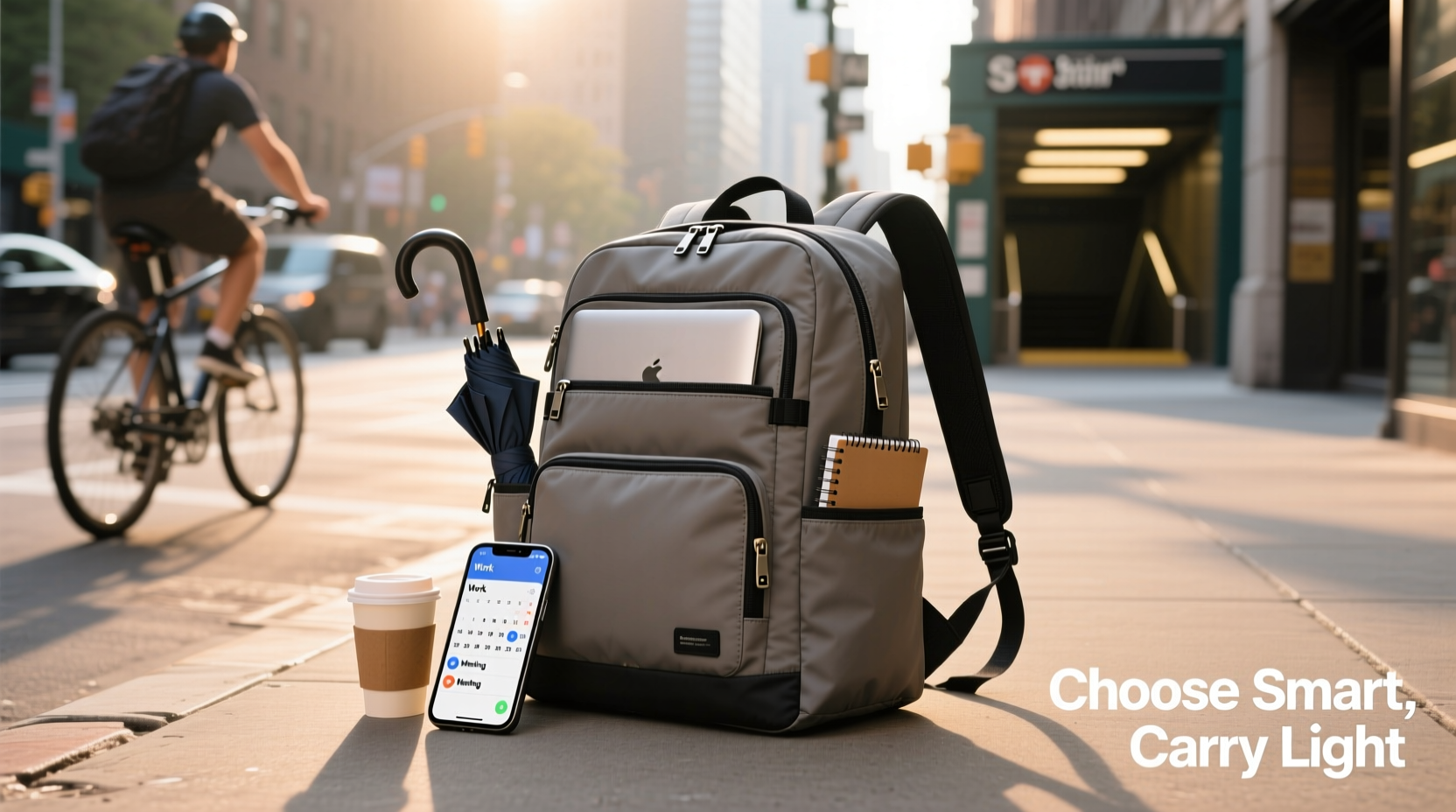Navigating urban commutes with a laptop, gym clothes, lunch, and personal items demands more than just a backpack or briefcase—it requires a thoughtfully designed large capacity commuter bag. The right bag doesn’t just carry your belongings; it supports your posture, protects your electronics, and adapts to your schedule. Yet, with countless options flooding the market, selecting one that aligns with your real-world needs can feel overwhelming. The key lies in balancing function, durability, comfort, and style—without compromising on any.
Assess Your Daily Carry Requirements

Before evaluating materials or brands, start by mapping out what you actually carry each day. A software developer hauling a 15-inch laptop, power bank, and noise-canceling headphones has different needs than a teacher carrying lesson plans, books, and student work. Take inventory of your essentials:
- Laptop or tablet (include dimensions)
- Chargers, cables, or docking stations
- Gym clothes or footwear
- Lunch container or hydration bottle
- Umbrella, notebook, wallet, keys
Once listed, estimate total volume. Most large commuter bags range from 20 to 35 liters. A general rule: if your items exceed 15 pounds or fill more than two standard grocery bags, opt for a 25L+ design with structured compartments.
Key Features That Define a High-Performance Commuter Bag
Not all spacious bags are created equal. A truly effective large capacity commuter bag integrates smart design elements that enhance usability and longevity. Prioritize these core features:
Dedicated Laptop Compartment with Padding
A padded, suspended laptop sleeve—ideally with at least 1 inch of foam—protects against drops and pressure. Look for clamshell-style openings that allow full access when laid flat, reducing strain during airport security checks.
Water-Resistant or Weatherproof Materials
Urban environments mean unexpected rain, damp subway seats, and spilled coffee. Materials like ballistic nylon, Cordura, or waxed canvas offer excellent water resistance. Avoid untreated cotton or thin polyester unless paired with a removable rain cover.
Ergonomic Design and Weight Distribution
Bags exceeding 20L can become unwieldy. Opt for designs with:
- Padded, contoured shoulder straps
- Sternum or waist stabilizer straps (especially for backpacks)
- Reinforced back panels with airflow channels
Organization Without Clutter
Multiple zones prevent chaos. Ideal layouts include:
- Front quick-access pocket for phone, keys, transit card
- Internal mesh sleeves for cords and pens
- Separate ventilated compartment for shoes or wet items
“Commuter bags should act as mobile command centers—not storage bins. Organization is what separates functional from frustrating.” — Marcus Tran, Urban Gear Designer at CommuteLab
Material and Build Quality: What Lasts?
The material defines both durability and weight. While aesthetics matter, prioritize resilience for daily wear.
| Material | Pros | Cons | Best For |
|---|---|---|---|
| Ballistic Nylon | Extremely durable, abrasion-resistant | Heavier than alternatives | Heavy loads, frequent travelers |
| Cordura Fabric | Lightweight, water-repellent, strong | Higher cost | All-purpose urban commuting |
| Waxed Canvas | Classic look, naturally water-resistant | Requires maintenance, ages unevenly | Style-focused professionals |
| Recycled Polyester | Eco-friendly, lightweight | Less durable under heavy use | Light commuters, sustainability seekers |
Zippers should be YKK or equivalent—tested for tens of thousands of cycles. Stitching must be double- or triple-stitched at stress points like handles and strap anchors.
Real-World Example: Sarah’s Transition from Briefcase to Smart Commuter Pack
Sarah, a project manager in Chicago, used a leather briefcase for years. It looked professional but offered no padding for her laptop, forced her to carry gym clothes in a separate tote, and caused shoulder pain after long days. After switching to a 28-liter hybrid backpack with a ventilated shoe compartment, magnetic quick-access front pocket, and sternum strap, she reported reduced fatigue, fewer forgotten items, and smoother transitions between office, gym, and train rides. Her only regret? Not upgrading sooner.
Step-by-Step Guide to Selecting Your Ideal Bag
Follow this sequence to avoid impulse buys and ensure long-term satisfaction:
- Inventory your daily items – List everything you carry regularly.
- Measure your largest device – Note laptop/tablet dimensions to confirm compatibility.
- Determine preferred carry style – Backpack, tote, messenger, or hybrid? Consider posture and commute type (e.g., cycling vs. walking).
- Set a budget – Quality commuter bags range from $120–$300. View this as a 3–5 year investment.
- Test fit and weight – If buying in-store, load it with comparable weight. Check balance and ease of movement.
- Verify warranty and repair policy – Brands like Patagonia, Peak Design, and Aer offer lifetime repairs, signaling confidence in build quality.
Checklist: Must-Have Qualities in a Large Capacity Commuter Bag
- ✔️ Minimum 25-liter capacity
- ✔️ Padded, suspended laptop compartment (fits your device)
- ✔️ Water-resistant exterior fabric
- ✔️ Ergonomic straps with padding and stabilization options
- ✔️ Multiple internal and external organization pockets
- ✔️ Durable zippers and reinforced stitching
- ✔️ Hidden anti-theft pockets (optional but recommended)
- ✔️ Easy-to-clean interior lining
Frequently Asked Questions
Can a large commuter bag still be TSA-friendly?
Yes. Many modern commuter bags feature lay-flat laptop compartments that meet TSA requirements for easy screening. Look for models explicitly labeled “TSA-compliant” or “airport friendly.”
Is a backpack better than a messenger bag for heavy loads?
Generally, yes. Backpacks distribute weight evenly across both shoulders and the hips, reducing spinal strain. Messenger bags concentrate weight on one side, which may lead to postural imbalance over time. However, ergonomically designed messengers with chest straps can be viable for loads under 15 pounds.
How do I clean a large commuter bag?
Spot clean with a damp cloth and mild soap. For deeper cleaning, remove loose items, shake out debris, and wipe interior with a disinfectant-safe wipe. Never machine wash unless the manufacturer specifies it. Allow to air dry completely before reuse.
Final Thoughts: Invest in Function That Fits Your Life
Choosing the perfect large capacity commuter bag isn’t about chasing trends or maximum space—it’s about alignment with your actual routine. The best bag feels like an extension of your workflow: secure, intuitive, and reliable. Whether you're navigating rush hour, hopping between meetings, or heading straight from desk to dinner, the right bag eliminates friction and enhances efficiency. Don’t settle for bulk without brains. Assess your needs honestly, prioritize intelligent design, and select a bag built to last. Your future self—rushing through a downpour with dry gear and no shoulder pain—will thank you.









 浙公网安备
33010002000092号
浙公网安备
33010002000092号 浙B2-20120091-4
浙B2-20120091-4
Comments
No comments yet. Why don't you start the discussion?